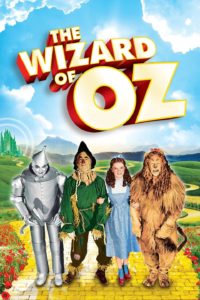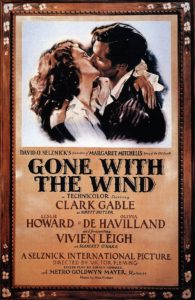It’s Oscar Season. The nominations have been announced; the votes are being collected, counted and calculated; and the winners will be announced on Sunday, February 24th, at the Dolby Theater in Los Angeles amidst much pomp and pageantry. I’m not a great fan of the event but am proud to share the history of two enduring heroines of the silver screen.
Dorothy, played by Judy Garland in The Wizard of Oz, and Scarlet O’Hara, played by Vivien Leigh in Gone With the Wind, were fictional characters who overcame catastrophic challenges and found that they had deep within themselves the power to not only survive but to attain their aspirations.
 The Wizard of Oz, produced by Metro Goldwyn Mayer, is widely considered to be one of the greatest films in cinematic history. It is the best known and most commercially successful adaptation of L. Frank Baum’s 1900 children’s book, The Wonderful Wizard of Oz, and has become an icon of American pop culture. It was nominated for six Academy Awards, including Best Picture, but lost to Gone with the Wind. It did however win Best Original Song for Over the Rainbow and Best Original Score. While the film was considered a critical success upon release in August 1939, it failed to make a profit for MGM. The 1956 television premiere on CBS reintroduced the film to the public, and watching it became an annual tradition. According to the Library of Congress it is the most seen film in movie history.
The Wizard of Oz, produced by Metro Goldwyn Mayer, is widely considered to be one of the greatest films in cinematic history. It is the best known and most commercially successful adaptation of L. Frank Baum’s 1900 children’s book, The Wonderful Wizard of Oz, and has become an icon of American pop culture. It was nominated for six Academy Awards, including Best Picture, but lost to Gone with the Wind. It did however win Best Original Song for Over the Rainbow and Best Original Score. While the film was considered a critical success upon release in August 1939, it failed to make a profit for MGM. The 1956 television premiere on CBS reintroduced the film to the public, and watching it became an annual tradition. According to the Library of Congress it is the most seen film in movie history.
 Gone with the Wind is an epic historical romance adapted from Margaret Mitchell’s 1936 novel of the same name. Set in the South against the backdrop of the Civil War and Reconstruction, the film tells the story of the strong-willed, feisty and flirtatious daughter of a Georgia plantation owner. The film experienced difficulties in casting and production but received positive reviews upon its release; although some reviewers found it overlong. Of thirteen nominations, it received eight awards including Best Picture and set records for the total number of nominations and wins at the time. It was immensely popular when first released, became the highest earning film made up to that point, and held that record for over a quarter of a century. When adjusted for monetary inflation, it is still the most successful film in box office history. Re-released periodically throughout the 20th century it has become ingrained in popular culture and is regarded as one of the greatest films of all time.
Gone with the Wind is an epic historical romance adapted from Margaret Mitchell’s 1936 novel of the same name. Set in the South against the backdrop of the Civil War and Reconstruction, the film tells the story of the strong-willed, feisty and flirtatious daughter of a Georgia plantation owner. The film experienced difficulties in casting and production but received positive reviews upon its release; although some reviewers found it overlong. Of thirteen nominations, it received eight awards including Best Picture and set records for the total number of nominations and wins at the time. It was immensely popular when first released, became the highest earning film made up to that point, and held that record for over a quarter of a century. When adjusted for monetary inflation, it is still the most successful film in box office history. Re-released periodically throughout the 20th century it has become ingrained in popular culture and is regarded as one of the greatest films of all time.
 My debut was not as auspicious, but then it didn’t have the backing of a major film studio or a multimillion dollar budget. The opening scene of my epic was an entire fifty-foot reel of 16 mm film of my birth certificate taken by my father. It was followed by myriad home movies that went on to chronicle my life by documenting all of the happy events and relationships. There were lots of laughs and lots of love, but the footage contained no negativity, no sorrow, no tears. Those were left for me to record, which I did in my book Je t’aime and song of the same name. Initially interest and distribution were among family and friends then expanded in availability through Amazon. There are several hundred copies in circulation, and it attained international status when it was read in Ireland, France, Poland and India. Comments were favorable and complimentary. Time will tell whether the story will endure. Perhaps one day it will make it to the big screen.
My debut was not as auspicious, but then it didn’t have the backing of a major film studio or a multimillion dollar budget. The opening scene of my epic was an entire fifty-foot reel of 16 mm film of my birth certificate taken by my father. It was followed by myriad home movies that went on to chronicle my life by documenting all of the happy events and relationships. There were lots of laughs and lots of love, but the footage contained no negativity, no sorrow, no tears. Those were left for me to record, which I did in my book Je t’aime and song of the same name. Initially interest and distribution were among family and friends then expanded in availability through Amazon. There are several hundred copies in circulation, and it attained international status when it was read in Ireland, France, Poland and India. Comments were favorable and complimentary. Time will tell whether the story will endure. Perhaps one day it will make it to the big screen.
Where is the picture in the raw?
Tony
As always, I enjoyed reading your blog.
Thank you for sharing.
Congrats!